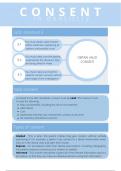CO N S E N
in dentistry
T
GDC standard 3
You must obtain valid consent
3.1 before treatment, explaining all
options and possible costs
You must make sure the patient OBTAIN VALID
3.2 understands the decisions they
are being asked to make
CONSENT
You must make sure that the
3.3 patients consent remains valid at
each stage of the investigation
Valid consent
As stated in the GDC standards, consent must be valid. This means it must
include the following:
Risks and benefits, including the risk of no treatment
Alternatives
Cost
Awareness that they can remove their consent at any time
Be voluntary and without coercion
Types of consent
Implied - This is when the patient implies they give consent, without verbally
expressing it. For example, a patient may consent to a dental examination when
they sit in the dental chair and open their mouth.
Express - For procedures other than dental examinations, including radiographs,
the patient's express consent (oral or written) is needed.
Informed - This is when the patient is given all of the relevant information about a
procedure, so that they can make an individual decision using that information
, Competence to consent
A patient is considered competent to consent for their treatment if they can:
Communicate the proposed treatment to others
Understand the treatment, and the risks, benefits and alternatives
Retain this information in the future
Evaluate the risks and benefits
Gillick competence
A landmark legal case Gillick v West In the UK, children aged 16 and over
Norfolk and Wisbech Area Health can legally consent for dental
Authority, resulted in the term Gillick procedures, if they are competent to do
competence. The case was centered so. This stands, even if their parent
around a patient under the age of 16 disagrees - unless the decision is
being prescriped contraception, without deemed to be unsafe.
parental consent.
Some children and young adults under
In this case, it was determined that age 16 may also be competent to
children and young adults are sometimes consent for treatment, if they meet the
competent to consent, despite being above criteria. In this case, they would
under the age of 16, resulting in the term be considered Gillick competent.
Gillick competence.
Eg. A 7-year old child requires extractions under general anaesthetic: A 7-year is
unlikely to be able to truly understand the risks involved with a general anaesthetic,
or evaluate their treatment options sensibly. They are therefore not Gillick
competent
Eg. A 13-year old child requires a restoration, with local anaesthetic. They are mature,
sensible and ask questions about the procedure. In this case, it is likely they are
Gillick competent as they are fulfilling the criteria to be considered competent,
including communicating the procedure, and understanding it.




